





First, the good news--as bold and buzzy as they seem, those big black bees that challenge you will not hurt you! Despite the nuisance of buzzing you or producing a little sawdust here and there, Carpenter Bees are important pollinators of trees and flowers.
The male Carpenter Bee is usually the only one you'll see in your garden, and he is harmless because he has no stinger. His dive-bombing and bumping tactics are merely an attempt to defend the nesting gallery that the female carved out of some delectable wood on your property. The female Carpenter Bee, on the other hand, DOES have a stinger, but is documented as being fairly docile unless handled. (Yeah, like I'm going to pick up a bee.) And the female spends most of her short life inside the nesting gallery, preparing food caches, laying eggs, and closing up the brood cell with wood pulp. Then she dies.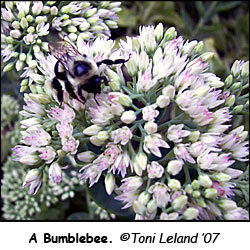
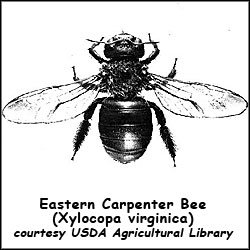 Carpenter Bees show up in the spring in most parts of the country. At that time, they mate to produce a single generation for that year. They look very much like Bumblebees, but the distinctive shiny black abdomen is how you can tell them apart; coarse black hairs cover the hind legs, and the male has white markings on the head. Bumblebees have yellow hairs on the abdomen, and pollen baskets on their hind legs; they nest in the ground.
Carpenter Bees show up in the spring in most parts of the country. At that time, they mate to produce a single generation for that year. They look very much like Bumblebees, but the distinctive shiny black abdomen is how you can tell them apart; coarse black hairs cover the hind legs, and the male has white markings on the head. Bumblebees have yellow hairs on the abdomen, and pollen baskets on their hind legs; they nest in the ground.
Carpenter Bees have been given a bad name because they encroach on human structures, but the bottom line in most literature is that they cause mostly cosmetic damage rather than structural damage. Exceptions to this are instances of repeated colonization of the same spot, in which case, the wood becomes structurally weakened. Our friendly Woody Woodpecker also contributes to unsightly damage by working on places where there might be something to eat.
A sure sign that you have Carpenter Bees is evidence of sawdust on the ground below places where wood is accessible, and preferably weathered. (Painted or sealed wood is a good deterrent to these insects.)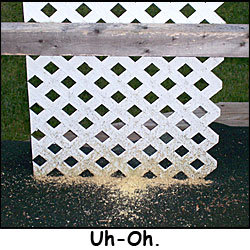
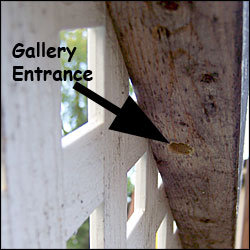 The female chews a less than half-inch, perfectly round hole in a protected area of the wood, progressing in about 2 inches. She then makes a hard right and works along the inside of the wood for about 4 to 6 inches, chewing at the rate of about an inch every six days.
The female chews a less than half-inch, perfectly round hole in a protected area of the wood, progressing in about 2 inches. She then makes a hard right and works along the inside of the wood for about 4 to 6 inches, chewing at the rate of about an inch every six days.
While she's working, the males bring food and defend the nest.
To discourage Carpenter Bees from chewing into your own structures, keep exposed wood surfaces well painted, and seal and re-paint any weathered areas on already painted wood; seal any gallery entrances you find so as to discourage next year's crop from re-using the space.
If you intend to exterminate the bees, either mechanical or chemical methods yield good results.
Fly-swatters or tennis rackets can be used to swat down flying males. The gallery entrance can be plugged to trap the insects inside. This should be done after dark on a cool evening when the insects are not active. Wear protective clothing, as the female will be come aggressive and CAN sting. Methods for plugging the entrance and gallery include caulking compound, wood putty, or a wooden dowel covered with glue. Expanding foam has been used with some success, but it makes a mess.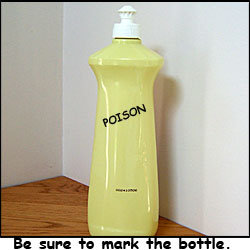 The best form of chemical control is carbaryl (Sevin®) powder squirted into the opening. Again, do this after dark. The insects walk through the insecticide and carry it into the nest, and newly emerging adults will have to walk through it to leave the gallery.
The best form of chemical control is carbaryl (Sevin®) powder squirted into the opening. Again, do this after dark. The insects walk through the insecticide and carry it into the nest, and newly emerging adults will have to walk through it to leave the gallery.
A handy way to inject powdered products (not just insecticides) is to use a clean, dry container with a push-pull cap (like the ones used for liquid dishwashing soap). Put the powder inside, pull the cap to open the end, insert it into the hole, and squeeze hard several times. Important! Be sure to wear protective eye-wear and a filter mask when doing this.
Trying to use liquid insect spray on the flying males is a losing game. They are too fast and seldom land on anything long enough to make contact with them.
"Carpenter Bee" by Terry Price, George Forestry Commission, Bugwood.org
Unless otherwise noted, all images are ©Toni Leland
Copyright © www.100flowers.win Botanic Garden All Rights Reserved